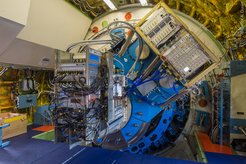A last GREAT opportunity for decades to come
GREAT prepares for SOFIA’s last flight mission
With the joint decision of NASA and the German Aerospace Center (DLR) to discontinue flight operations of the Stratospheric Observatory for Infrared Astronomy (SOFIA) in September 2022, unique science opportunities for high-resolution FIR spectroscopy with the German spectrometer GREAT (German Receiver for Astronomy at Terahertz Frequencies) will also cease. GREAT is a development by the Max-Planck-Institut für Radioastronomie and the Kölner Observatorium für Submillimeter-Astronomie (KOSMA)/ Universität zu Köln, in cooperation with the DLR Institut für Optische Sensorsysteme which has been funded largely independent of the German Aerospace Center’s budget. GREAT observations were highly demanded by the general SOFIA user community.

The Stratospheric Observatory for Infrared Astronomy (SOFIA) will take off from New Zealand in July and August 2022 with the German GREAT spectrometer on board for its final twenty observating flights. With the joint decision of NASA and the German Aerospace Center (DLR) to discontinue flight operations in September 2022, unique science opportunities for high-resolution FIR spectroscopy with GREAT will also cease.
With SOFIA, a converted Boeing aircraft with a flight altitude above 13 kilometres, scientists can observe at a wavelength range that is not accessible from the ground. The spectral high-resolution imaging spectrometer GREAT (German Receiver for Astronomy at Terahertz Frequencies) on board SOFIA can create a kind of chemical fingerprint of extensive regions of the sky with high spatial and spectral resolution. GREAT is a development by the Max-Planck-Institut für Radioastronomie and the Kölner Observatorium für Submillimeter-Astronomie (KOSMA) / University of Cologne, in cooperation with the DLR Institut für Optische Sensorsysteme. Its development has been financed by the participating institutes, by the German Aerospace Center (DLR), and within the Collaborative Research Centre 956, funded by the German Science Foundation (DFG).
Since its first light on board SOFIA on 1 April 2011, GREAT has serviced close to 250 successful science flights, collecting 2,000 hours of science data – truly unique data with high legacy value that could not have been observed otherwise. The operating frequencies of the spectrometer are specifically selected to include spectral lines of high astrophysical relevance in the far-infrared spectral range where Earth’s atmosphere is completely opaque for ground-based observations.
GREAT has addressed a wide range of science topics – in close collaboration with the interested international science communities – from terrestrial and planetary research to studies of star formation and the physics and chemistry of the interstellar medium in our and nearby galaxies. A particular focus has been on efficient large-scale mapping of the atomic fine-structure lines of carbon and oxygen, which are the strongest cooling lines of the star-forming interstellar medium.
Among the new molecules that have been observed with GREAT, the first detection of long searched Universe’s earliest molecular bond, the helium hydride ion HeH+, received widest international attention. The scientific results of the GREAT observations have been presented in numerous publications in scientific journals, including the results from the early science flights in a special volume of Astronomy & Astrophysics, and in many presentations at conferences and workshops.
Immediate access to the airborne platform, different to space missions, allowed the GREAT consortium to maintain the instrument at its – fast evolving – technologic frontiers. Starting with single-channel liquid-Helium cooled detectors, the instrument was upgraded in 2015-16 to the most competitive FIR array heterodyne spectrometer ever, operating 14+7 pixels simultaneously, in two frequency bands. It thus outperformed previous space-based experiments by more than an order of magnitude in observing speed. The instrument design paper received the ‘2018 THz Science and Tech. Best Paper Award’ of the prestigious IEEE Microwave Theory and Techniques Society.
The GREAT team and its user community are now looking forward to the successful close-out of ongoing observing Cycle 9 projects during the upcoming, final southern deployment to New Zealand.
--------------------------------------------------------------------------------
GREAT: the German Receiver for Astronomy at Terahertz Frequencies (GREAT), is a development by the Max-Planck-Institut für Radioastronomie and the Kölner Observatorium für Submillimeter-Astronomie (KOSMA)/ Universität zu Köln, in cooperation with the DLR Institut für Optische Sensorsysteme. The development has been financed by the participating institutes, by the German Aerospace Center (DLR) under grants 50 OK 1102, 1103 and 1104, and within the Collaborative Research Centre 956, funded by the Deutsche Forschungsgemeinschaft (DFG).
